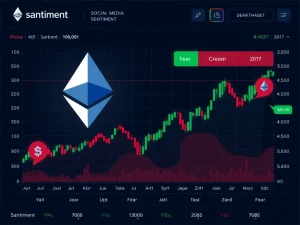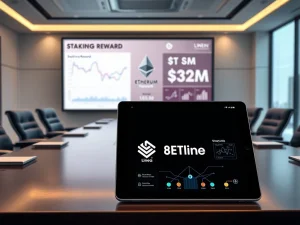RESOLV Explodes: Protocol Fee Switch Ignites 11% Surge, Market Cap Hits $47M

Are you tracking the latest shifts in the crypto market? **RESOLV** just made headlines with an impressive 11% surge, catapulting its market capitalization to a notable $47 million. This sudden jump wasn’t random; it was primarily triggered by a strategic move: the activation of a **protocol fee switch** designed to reward its dedicated stakers. This pivotal event has ignited fresh interest in RESOLV’s token economics and governance, signaling a potentially transformative phase for the project. Let’s dive into what this means for the future of **RESOLV** and its place in the evolving blockchain landscape.
RESOLV’s Astonishing Surge: What Drove the 11% Jump?
In late July 2025, the RESOLV token experienced a significant short-term surge, climbing over 11% and pushing its total **market cap** to $47 million. This remarkable rally, initially reported by BlockBeats, directly coincided with the implementation of a **protocol fee switch**. This mechanism is designed to redirect a portion of the protocol’s generated fees directly to those who stake RESOLV tokens, thereby enhancing their **staking rewards**.
The price increase marked a sharp departure from recent volatility, indicating renewed investor confidence in the project’s underlying token economics and its governance model. While specific technical details or the exact timing of the fee adjustment were not widely publicized, the market’s enthusiastic response clearly underscored a growing belief in RESOLV’s ability to align incentives for its token holders. This strategic shift aims to foster greater participation and strengthen the token’s long-term value proposition.
The Power of a Protocol Fee Switch: Incentivizing Staking Rewards
A **protocol fee switch** is a powerful tool in decentralized finance (DeFi) that allows a project to direct fees generated by its network or applications to specific beneficiaries, often token holders or stakers. For RESOLV, activating this switch means:
- Enhanced Staking Rewards: Stakers now receive a direct share of the protocol’s revenue, making staking more attractive.
- Increased Incentive to Hold: By tying token holding to direct financial benefits, the fee switch encourages long-term holding rather than short-term trading.
- Improved Liquidity and Security: More tokens locked in staking can lead to greater network security and potentially more stable liquidity.
- Community Alignment: It creates a stronger alignment of interests between the protocol’s success and the financial well-being of its community members.
This move is a clear signal from the RESOLV team about their commitment to creating a sustainable and rewarding ecosystem for their community. It’s a fundamental change that directly impacts the token’s utility and potential for passive income through **staking rewards**.
Understanding RESOLV’s Market Cap: A Mid-Cap Player’s Potential
With its **market cap** reaching $47 million, **RESOLV** now firmly positions itself as a mid-cap player within the vast and diverse blockchain ecosystem. While this valuation is modest when compared to industry giants like Nasdaq, which reported Q2 2025 market services revenue of $306 million, it signifies substantial growth and potential for a newer project.
The surge occurred amidst a broader mixed performance across various sectors in July 2025. For instance, traditional financial institutions like Eagle Bancorp reported a Q2 2025 loss of $2.30 per share, significantly below forecasts. In contrast, industrial players like A.O. Smith maintained a robust 14% leverage ratio despite a $178 million cash balance. These contrasting outcomes highlight sector-specific divergences, with technology and blockchain assets often outperforming traditional industries, attracting investor attention seeking higher growth.
Investors appear to be focusing on RESOLV’s potential for rapid expansion, particularly as the protocol’s fee model shift could significantly enhance staking rewards and liquidity, drawing in more capital and participants. This $47 million valuation is not just a number; it represents growing investor confidence in RESOLV’s strategic direction and its capacity for future development.
Navigating the Crypto Surge Amidst Broader Market Trends
The **crypto surge** experienced by RESOLV also aligns with a broader ‘risk-on’ sentiment observed in global markets during the same period. This optimism was evident even as macroeconomic uncertainties loomed, such as renewed Trump-era trade tensions prompting the European Union to threaten $117 billion in retaliatory tariffs on U.S. goods. Despite these geopolitical headwinds, the token’s rally suggested strong sector-specific demand, potentially driven by its product roadmap, strategic partnerships, or growing developer activity.
This environment of selective optimism also saw record highs in U.S. and European indices. Japanese automakers like Toyota saw double-digit gains following shifts in trade policy, while UK markets reached all-time highs. This broader trend indicates a preference for high-growth, technology-driven assets. However, RESOLV’s performance remains more directly tied to its internal developments and the efficacy of its **protocol fee switch** rather than solely relying on macroeconomic factors.
Actionable Insights for RESOLV Holders and Future Investors
As of July 25, 2025, RESOLV’s market capitalization and price surge mark a pivotal moment for the project. The decision to redirect fees toward stakers demonstrates a strategic shift aimed at incentivizing participation and liquidity, which are crucial for bolstering long-term adoption. For current and prospective investors, here are some key takeaways:
- Monitor Roadmap Execution: Sustaining this momentum will depend heavily on RESOLV’s ability to execute its product roadmap and deliver on promised features.
- Assess Staking Opportunities: The enhanced **staking rewards** make RESOLV an interesting proposition for those looking for passive income within the crypto space.
- Understand Market Context: While internal developments are key, remaining aware of the broader regulatory and economic climate is essential for informed decision-making.
- Evaluate Governance Participation: A strong, active community participating in governance can contribute significantly to the protocol’s resilience and growth.
Analysts have not provided specific forecasts for RESOLV’s trajectory, but the market’s positive reaction implies expectations of improved operational transparency and stronger financial performance stemming from the new fee model.
The recent **RESOLV** **crypto surge**, propelled by the activation of its **protocol fee switch**, underscores the profound impact that well-designed token economics can have on a project’s valuation and community engagement. By directly incentivizing stakers through enhanced **staking rewards**, RESOLV has not only seen its **market cap** climb to $47 million but has also signaled a robust commitment to its ecosystem’s long-term health. As the project continues to navigate a dynamic market, its ability to execute its vision and adapt to evolving conditions will be crucial for maintaining this impressive momentum and solidifying its position as a significant player in the blockchain arena.
Frequently Asked Questions (FAQs)
1. What is a protocol fee switch in cryptocurrency?
A protocol fee switch is a mechanism within a blockchain protocol that allows a portion of the fees generated from network activities (like transactions or services) to be redirected. In RESOLV’s case, these fees are now directed towards stakers, offering them a share of the protocol’s revenue.
2. How did the fee switch impact RESOLV’s token price?
The activation of RESOLV’s protocol fee switch directly coincided with an 11% short-term surge in its token price. This suggests that investors reacted positively to the new economic model, anticipating increased value and incentives for token holders and stakers.
3. What is RESOLV’s current market capitalization?
Following the surge, RESOLV’s market capitalization reached $47 million, positioning it as a mid-cap player within the blockchain ecosystem.
4. How does RESOLV’s performance compare to broader market trends?
While RESOLV’s surge occurred during a period of mixed performance in traditional equities and broader market optimism for tech assets, its gains were primarily driven by internal developments, particularly the fee switch, rather than solely macroeconomic factors.
5. What are the long-term implications of RESOLV’s fee switch for stakers?
The fee switch is expected to significantly enhance staking rewards, making RESOLV staking more attractive. This could lead to increased participation, improved liquidity, and a stronger alignment between the protocol’s success and the financial benefits for its stakers, fostering long-term adoption.
6. What factors should investors consider regarding RESOLV’s future?
Investors should monitor RESOLV’s execution of its product roadmap, the sustainability of its enhanced staking rewards, and how it navigates the volatile regulatory and economic climate. Community participation in governance is also a key factor for long-term success.








